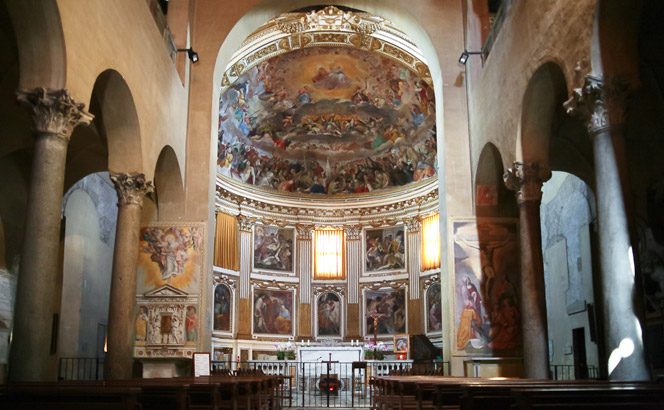Fr Bernard Healy
Notebook
Christ tells us, “nothing is hidden but it will be made clear, nothing secret but it will be made known and brought to light” (Luke 8:17). That’s not a bad meditation for Advent when we reflect both on the Word of God making himself visible to us in the stable in Bethlehem and his coming at the end of time when all that is secret will be laid bare.
One particular church in Rome strikes me as the epitome of the hidden being brought to light. I mean the Basilica of the Santi Quattro Coronati [pictured], which stands behind the Pontifical Irish College. Named for four ‘crowned saints’, i.e. martyrs, who died under the Emperor Diocletian about 1,700 years ago, the building is about as unassuming as they come.
Although experts can look at the brickwork on the outside and identify some of it as dating back to the original 4th Century foundation, to the casual observer the building looks more like some kind of dilapidated brick barracks than a fine church.
This is easily explained by the history of the place – following the destruction of this part of Rome by the Normans in 1084, the basilica was rebuilt as a fortified monastery, a small castle, in the early 12th Century. Defence rather than aesthetics was the priority.
However, this unprepossessing exterior conceals a jewel-box of sacred art. Firstly, the church itself, hidden within the defensive walls of the monastery, is small but striking.
Exploration
Whilst parts of it date back to the 12th Century, it is dominated by an astonishing 17th Century fresco above the altar showing the four crowned saints entering into heavenly glory. A little exploration discloses other artworks and architectural features, each precious in their own way. Then, a nondescript door on the left of the church leads to the beautiful monastery cloister, one of the most peaceful and prettiest places in all of Rome.
Resident
Just outside the church, but still within the brick walls, is found the chapel of St Sylvester. To visit, you pass a donation through a hatch to one of the enclosed Augustinian nuns who have been resident here since 1564, and receive a key to enter the most gorgeous little chapel with 13th Century frescoes telling the story of St Sylvester, the Pope at the time of Constantine.
But that’s not the only secret hidden inside Santi Quattro Coronati. In recent years the removal of whitewash from one of the monastery rooms has uncovered what is known as the Gothic Hall.
For centuries a series of frescoes commissioned by the cardinal who lived there in the 1240s was hidden and then forgotten. So beautiful is this work that it has revolutionised our understanding of medieval art in Rome and so it is called the ‘Sistine Chapel of the Middle Ages’.
There is another way in which the Monastery of the Santi Quattro Coronati bears witness to the uncovering of what was once hidden. During World War II, Jews and other fugitives found refuge in the religious houses of Rome.
However, the question is asked as to what precise role Pius XII played in these concealments. Given the danger of reprisals, renewed persecution and the overrunning of the Vatican by German troops, the Pope chose a policy of public silence and ostensible neutrality.
This has led some to conclude that the mercy shown by the religious of Rome was done in opposition to the Pope! A recently-discovered wartime diary of the Santi Quattro Augustinian nuns helps refute this thesis. It recounts how the Pope ordered the Mother Superior to allow Jews and other fugitives to receive shelter even inside the monastic enclosure.
Not only did the Pope approve, he gave direct orders for the religious to do everything they could.
***
Great gifts of the Augustinians
The fullness of monastery life is always hidden; with the exception of their singing at the public liturgy, the Augustinian nuns work, pray and live behind closed doors. However, this enclosed life, and in particular the prayer of the sisters, brings great gifts to the Church as a whole.
One of these gifts was made visible by Pope Benedict XVI in Holy Week 2011, when the meditations of Sr Maria Rita Piccione of the Santi Quattro monastery were used for the Papal Stations of the Cross at the Colosseum – a public reminder of the hidden prayer of our monastic brothers and sisters.


 Santi Quattro Coronati
Photo: Italian Way
Santi Quattro Coronati
Photo: Italian Way 